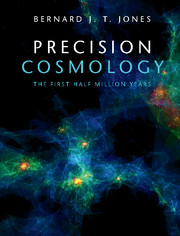Book contents
- Frontmatter
- Dedication
- Contents
- Preface
- Notation and Conventions
- Part I 100 Years of Cosmology
- Part II Newtonian Cosmology
- Part III Relativistic Cosmology
- 10 Minkowski Space
- 11 The Energy Momentum Tensor
- 12 General Relativity
- 13 Space-Time Geometry and Calculus
- 14 The Einstein Field Equations
- 15 Solutions of the Einstein Equations
- 16 The Robertson–Walker Solution
- 17 Congruences, Curvature and Raychaudhuri
- 18 Observing and Measuring the Universe
- Part IV The Physics of Matter and Radiation
- Part V Precision Tools for Precision Cosmology
- Appendix A SI, CGS and Planck Units
- Appendix B Magnitudes and Distances
- Appendix C Representing Vectors and Tensors
- Appendix D The Electromagnetic Field
- Appendix E Statistical Distributions
- Appendix F Functions on a Sphere
- Appendix G Acknowledgements
- References
- Index
12 - General Relativity
from Part III - Relativistic Cosmology
Published online by Cambridge University Press: 04 May 2017
- Frontmatter
- Dedication
- Contents
- Preface
- Notation and Conventions
- Part I 100 Years of Cosmology
- Part II Newtonian Cosmology
- Part III Relativistic Cosmology
- 10 Minkowski Space
- 11 The Energy Momentum Tensor
- 12 General Relativity
- 13 Space-Time Geometry and Calculus
- 14 The Einstein Field Equations
- 15 Solutions of the Einstein Equations
- 16 The Robertson–Walker Solution
- 17 Congruences, Curvature and Raychaudhuri
- 18 Observing and Measuring the Universe
- Part IV The Physics of Matter and Radiation
- Part V Precision Tools for Precision Cosmology
- Appendix A SI, CGS and Planck Units
- Appendix B Magnitudes and Distances
- Appendix C Representing Vectors and Tensors
- Appendix D The Electromagnetic Field
- Appendix E Statistical Distributions
- Appendix F Functions on a Sphere
- Appendix G Acknowledgements
- References
- Index
Summary
The notion that gravity is a manifestation of the curvature of space-time is a remarkable idea. Going beyond the idea and putting it into a useful mathematical form was perhaps even more extraordinary. The technical difficulties are a huge barrier to understanding and using the theory.
We discuss the discovery and the principles that Einstein had to lay down in order to be able to realise this idea without disrupting all of known physics. It would be essential to keep the idea of local inertial frames. These principles must be put in a geometric framework that builds on local inertial frames and tries to connect local inertial frames that are accelerating relative to one another. Grossmann's suggestion had been that Riemannian space-time would provide such a structure when equipped with a metric and a way of connecting these different local inertial frames.
The Early Years
Today we see the general theory of relativity as a complete package with rules for calculating gravitational fields and their effects. That is, however, not how it came about. Like the development of electrodynamics during the previous century, the theory of gravitation came in steps. However, the theory of gravitation emerged over a relatively short period of time, reaching a crescendo in 1915 when both Einstein and Hilbert presented, in the same month, different derivations of the gravitational theory that survive to this day.
Einstein's own development of his theory of gravitation was almost a one-person undertaking lasting more than a decade. It followed on from his publication of the Special Theory of Relativity in 1905, starting with work on the influence of gravitation on the propagation of light. However, Einstein was not the only one in search of a theory of gravitation. Planck had already asserted that all forms of energy would be influenced by gravitational fields, and by 1912 Mie had produced an impressive theory of gravitation (Smeenk and Martin, 2005), based purely on electrodynamics, but remaining firmly within the framework of special relativity. Mie's work had inspired Hilbert to join in the quest to unify gravitation and electrodynamics (Corry, 1999; Sauer, 2007; Renn and Schemmel, 2012).
- Type
- Chapter
- Information
- Precision CosmologyThe First Half Million Years, pp. 290 - 306Publisher: Cambridge University PressPrint publication year: 2017



